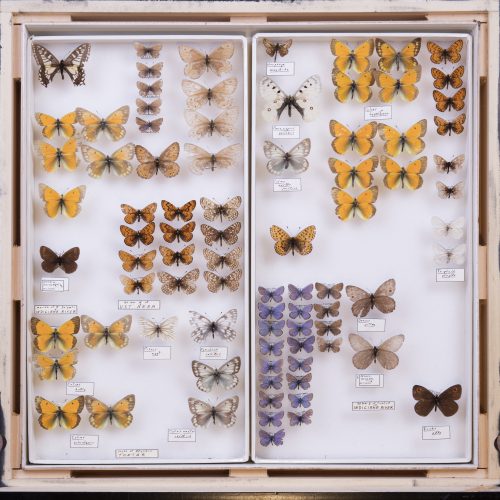New interactive website displays massive butterfly and moth collection
April 15, 2019
Jeff Richardson
907-474-6284

A new website launched by the University of Alaska Fairbanks will allow the public to view high-resolution images of thousands of butterflies and moths gathered by renowned collector Kenelm Philip.
Philip, who died in 2014 at age 82, was a research associate of the Smithsonian Institution, the University of Alaska Museum of the North and the UAF Institute of Arctic Biology. He gathered more than 111,000 specimens from Alaska, Canada and Russia, the largest private collection of Arctic butterflies in the world.
Now anyone can view images from more than 400 drawers from the collection at https://kenphilipcollection.alaska.edu/. UAF graduate student Kathryn Daly initially curated the drawers. UAF undergraduate student Nina Sikes photographed them in 2016, after the collection had been moved from Philip’s home in Fairbanks to the UA Museum of the North. Philip arranged for most of his pinned specimens to be donated to the Smithsonian National Museum of Natural History.
Derek Sikes, the UA museum's curator of insects, was stunned when he first saw the collection.
“It was the largest private insect collection I had ever seen,” said Sikes, who is also professor of entomology in UAF’s Biology and Wildlife Department. “Its value for science was obviously enormous, and it was also just beautiful to behold.”
The website includes photographs Philip took of live butterflies, along with information about his life and legacy. Philip founded the Alaska Lepidoptera Survey, which provided gear and instructions for more than 600 Alaskans to collect butterflies and moths for science.
Derek Sikes and Jennifer Moss, an instructional designer at UAF eCampus, designed and built the website. They hope it will provide a lasting and wide-reaching record of Philip’s collection, along with resources for education and research.
The website includes lesson-plan ideas for using the collection website. Collection data are available for specimens in each drawer of Beringian and Alaska specimens, and selected butterflies and moths were imaged with a scanning electron microscope at UAF’s Advanced Instrumentation Laboratory.
The collection, which includes records from the 1970s to 2013, is a great resource for studying how nature has changed over time, Sikes said.
“It’s almost like having a time machine,” he said. “How else can one assess changes across many decades in body size and flight activity, or compare DNA samples, without well-preserved specimens from the past?”
ADDITIONAL CONTACT: Derek Sikes, dssikes@alaska.edu.


